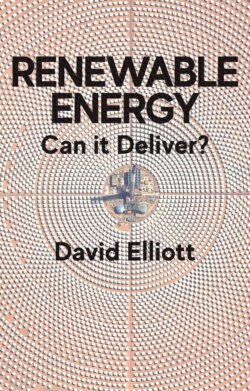Читать книгу Renewable Energy - David Elliott - Страница 16
Box 1.3 Energy and power units
ОглавлениеThe terms ‘power’ and ‘energy’ are sometimes used interchangeably, which can be confusing. In this book, ‘power’ is used to mean electric power, whereas ‘energy’ covers all sources/end uses (power, heat and transport), not just electricity, although of course some electricity is used for heating and for transport.
In physics, the definition of power is more specific. It is a measure of the ability (or capacity) of a device to do work, rendered in watts and multiples of watts: 1,000 watts is a kilowatt (kW), 1,000 kW is a megawatt (MW), 1,000 MW is a gigawatt (GW), 1,000 GW is a terawatt (TW). Energy also has a more specific meaning in physics. Strictly, it is always conserved and cannot be ‘generated’ or ‘consumed’, only converted from one form to another. But we still commonly talk of energy generation and consumption, and the amount of energy converted (generated or consumed) is measured as power × time, i.e. the power of the device multiplied by how long it is run for, so it is ‘kilowatt hours’ (kWh) and multiples, MWh, GWh and TWh.
There will always be losses in energy conversion from one form to another and so, for a generation system, the finally available end-use energy will be less than the so-called primary energy inputs (for example, the energy in the fuel used in fossil-fuel-fired plants). The actual energy output of a generation plant will also usually be less than the theoretical full output possible for the plant, especially for systems using variable renewable sources, since they cannot deliver their full theoretically possible output all the time. ‘Capacity factors’ (also called ‘load factors’) are cited for the percentage of the theoretical maximum output capacity that is actually available annually to meet demand loads.
There are some issues with the way renewables are handled in energy analysis, since renewables like wind and solar do not use fuel. To produce a figure for primary energy that is compatible with those used for fossil fuel plans, the output from the renewable plant is sometime ‘grossed up’ by a factor of around three, to reflect the amount of primary fossil energy that would have to be used (given the large losses in fossil energy conversion) to produce the same output. The same is sometimes done with nuclear plants and biomass plants. It might be argued that it would better just to compare final energy outputs in each case. But, done that way round, to get the same output as a wind or solar plant a fossil plant could be depicted as having, nominally, to consume around three times more primary fuel (Sauar 2017).
Although, as I will be exploring, there can be disagreements about the likely technical and economic viability of new energy technologies, the wider climate change and environmental aspects and issues are sometimes even more controversial. For example, there are sometimes fierce debates concerning the likely social and environmental impacts of the combustion of fossil fuel and energy use, and also over how they might be avoided or lessened. However, the basic emissions situation is relatively clear. Box 1.4 summarizes the current global pattern of energy use, in very simplified terms, and also, in rough outline, the resultant global carbon emissions. They are both still expanding.
